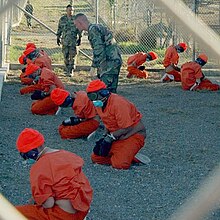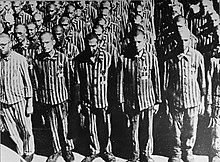Prison uniform

A prison uniform is any uniform worn by individuals incarcerated in a prison, jail or similar facility of detention.
United States of America
Prison uniforms in America often consist of a distinctive orange or yellow jumpsuit (originally a horizontal white and black bee-striped uniform) or two piece surgical scrub set to make escape more difficult, as it is difficult for an escaped inmate to avoid recognition and recapture in such a distinctive attire. Many Jails today are also allowing inmates wear Sweatpants to keep comfortable. Many Juvenile Facilities have sweatpants as standard unifrom. They mostly use the colors: Navy Blue, Grey, and Orange.
While the uniform varies between states, federal facilities require tan slacks and a matching button down shirt.
Striped prison uniforms commonly used in the 19th century were abolished in the United States early in the 20th century because their continued use as a badge of shame was considered undesirable.[1] Through most of the twentieth century attitudes were different towards philosophies of rehabilitation. Fair treatment of prisoners and a growing number of non-violent, working class offenders prompted such a change in attitudes, and clothing and conditions changed to serve the concept of rehabilitation rather than punishment. As a result, work clothes were introduced, perhaps because of the concept of honest labor helping to turn an inmate into a honest citizen. Blue jeans and light blue denim or chambray work shirts became the-norm, a tradition still followed in some state prison systems today. In federal prisons, this concept was introduced in the form of khaki pants and shirts, still in use.
Only within the last twenty years have jumpsuits and scrubs become popular, and mostly out of economic issues. In many cases, prison uniforms usually consist of clothing better suited to the comfort and durability required for long term inmates, and these new uniforms are thus used mostly in local jails for short term inmates and offenders awaiting trial or transportation to a more permanent facility.
A recent trend to use uniforms as a measure of punishment has become increasingly popular. Sheriff Joe Arpaio in Arizona resorts to stripes and harsh conditions for his inmates, including pink underpants for his male charges. [2]
Britain

In Britain, prison uniforms formerly consisted of a white jacket, trousers and pillbox hat, all stamped with the broad arrow to denote crown property.
In 1693, Henry Sydney, Earl of Romney, was appointed as Master-General of the Ordnance. His personal heraldic crest was a pheon or broad arrow. He decided to mark all the stores under his control with this symbol and this practice gradually spread through all Government clothing, usually a discreet mark on the collar.
The idea of covering the uniforms of Penal Servitude prisoners with the broad arrow was first introduced by Sir Edmund Du Cane in the 1870s after his appointment as Chairman of Convict Directors and Surveyor-General of prisons. Du Cane considered the broad arrow to be a hindrance to escape and also a mark of shame. It was certainly unpopular with the convicts. “All over the whole clothing were hideous black impressions of the Broad Arrow”, wrote one prisoner.[3] Another considered the “hideous dress” to be “the most extraordinary garb I had ever seen outside a pantomime”.[4] Men sent to public-works prisons were issued with boots. One prisoner, Jeremiah O’Donovan Rossa, left this description: “Fully fourteen pounds in weight. I put them on and the weight of them served to fasten me to the ground. It was not that alone, but the sight of the impression they left on the gutter as you looked at the footprints of those who walked before you, struck terror to your heart. There was the felon’s brand of the ‘broad arrow’ impressed on the soil by every footstep…the nails in the soles of your boots and shoes were hammered in an arrow shape, so that whatever ground you trod you left traces that Government property had travelled over it.”[5] The broad arrow markings were used until 1922.[6]
References
- ^ Pratt, John Clark (2002). Punishment and civilization: penal tolerance and intolerance in modern society. Thousand Oaks, Calif: Sage. pp. p. 76. ISBN 0-7619-4753-1.
The distinctive prison stripes were abolished in 1904. …stripes had come to be looked upon as a badge of shame and were a constant humiliation and irritant to many prisoners' (Report of the New York (State) Prison Department, 1904: 22)
{{cite book}}:|pages=has extra text (help) - ^ "The sheriff who issues pink underwear", People's Weekly World, 12 February 2004
- ^ Five Years Penal Servitude by One-who-has-endured-it (1877)
- ^ My Prison Life (1901), Jabez Spencer Balfour
- ^ Irish Rebels in English Prisons (1882), Jeremiah O’Donovan Rossa
- ^ "Alexander Paterson, youth work and prison reform", Infed.org, 2004
